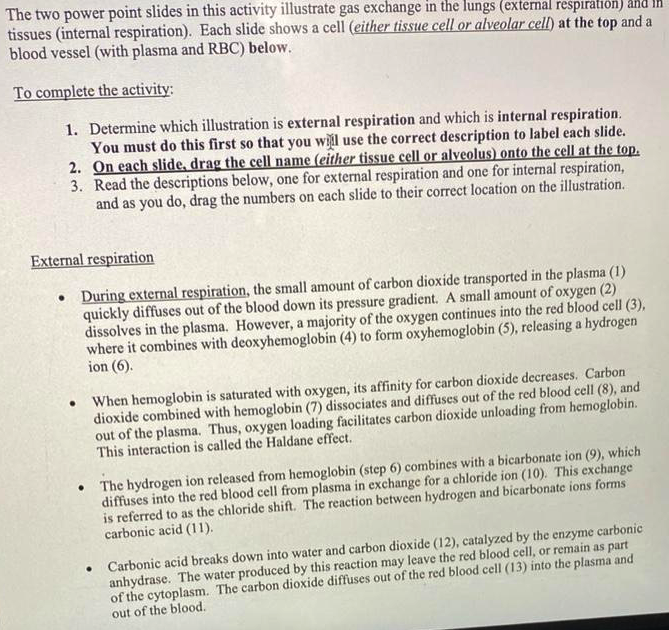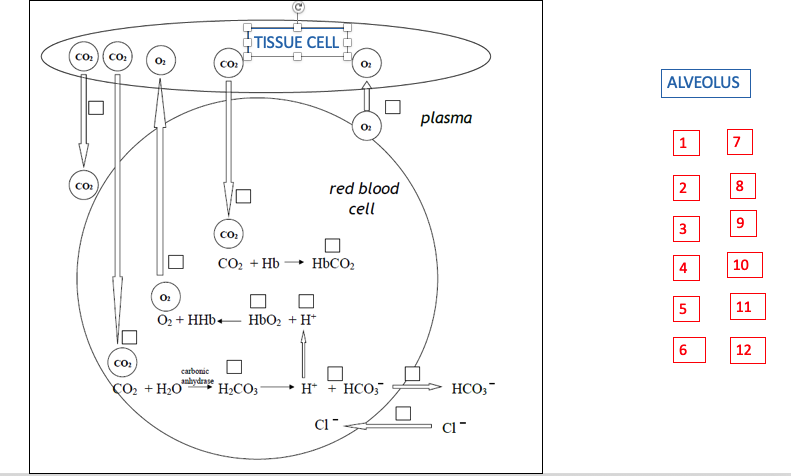The two power point slides in this activity illustrate gas exchange in the lungs (external respiration) tissues (internal respiration). Each slide shows a cell (either tissue cell or alveolar cell) at the top and a blood vessel (with plasma and RBC) below. To complete the activity: 1. Determine which illustration is external respiration and which is internal respiration. You must do this first so that you wil use the correct description to label each slide. 2. On each slide, drag the cell name (either tissue cell or alveolus) onto the cell at the top. 3. Read the descriptions below, one for external respiration and one for internal respiration, and as you do, drag the numbers on each slide to their correct location on the illustration. External respiration During external respiration, the small amount of carbon dioxide transported in the plasma (1) quickly diffuses out of the blood down its pressure gradient. A small amount of oxygen (2) dissolves in the plasma. However, a majority of the oxygen continues into the red blood cell (3), where it combines with deoxyhemoglobin (4) to form oxyhemoglobin (5), releasing a hydrogen ion (6). When hemoglobin is saturated with oxygen, its affinity for carbon dioxide decreases. Carbon dioxide combined with hemoglobin (7) dissociates and diffuses out of the red blood cell (8), and out of the plasma. Thus, oxygen loading facilitates carbon dioxide unloading from hemoglobin. This interaction is called the Haldane effect. • The hydrogen ion released from hemoglobin (step 6) combines with a bicarbonate ion (9), which diffuses into the red blood cell from plasma in exchange for a chloride ion (10). This exchange is referred to as the chloride shift. The reaction between hydrogen and bicarbonate ions forms carbonic acid (11). • Carbonic acid breaks down into water and carbon dioxide (12), catalyzed by the enzyme carbonic anhydrase. The water produced by this reaction may leave the red blood cell, or remain as part of the cytoplasm. The carbon dioxide diffuses out of the red blood cell (13) into the plasma and out of the blood. TISSUE CELL ( CO: CO: O2 ALVEOLUS plasma 1 CO: red blood 8 cell 9. CO: CO2 + Hb HBCO2 4 10 5 11 O2 + HHb+ HbO2 + H* 6 12 CO: carbonic anhydrase CO + H20" H2CO3 • H* + HCO, HCO;- 7. 2. 3.
The two power point slides in this activity illustrate gas exchange in the lungs (external respiration) tissues (internal respiration). Each slide shows a cell (either tissue cell or alveolar cell) at the top and a blood vessel (with plasma and RBC) below. To complete the activity: 1. Determine which illustration is external respiration and which is internal respiration. You must do this first so that you wil use the correct description to label each slide. 2. On each slide, drag the cell name (either tissue cell or alveolus) onto the cell at the top. 3. Read the descriptions below, one for external respiration and one for internal respiration, and as you do, drag the numbers on each slide to their correct location on the illustration. External respiration During external respiration, the small amount of carbon dioxide transported in the plasma (1) quickly diffuses out of the blood down its pressure gradient. A small amount of oxygen (2) dissolves in the plasma. However, a majority of the oxygen continues into the red blood cell (3), where it combines with deoxyhemoglobin (4) to form oxyhemoglobin (5), releasing a hydrogen ion (6). When hemoglobin is saturated with oxygen, its affinity for carbon dioxide decreases. Carbon dioxide combined with hemoglobin (7) dissociates and diffuses out of the red blood cell (8), and out of the plasma. Thus, oxygen loading facilitates carbon dioxide unloading from hemoglobin. This interaction is called the Haldane effect. • The hydrogen ion released from hemoglobin (step 6) combines with a bicarbonate ion (9), which diffuses into the red blood cell from plasma in exchange for a chloride ion (10). This exchange is referred to as the chloride shift. The reaction between hydrogen and bicarbonate ions forms carbonic acid (11). • Carbonic acid breaks down into water and carbon dioxide (12), catalyzed by the enzyme carbonic anhydrase. The water produced by this reaction may leave the red blood cell, or remain as part of the cytoplasm. The carbon dioxide diffuses out of the red blood cell (13) into the plasma and out of the blood. TISSUE CELL ( CO: CO: O2 ALVEOLUS plasma 1 CO: red blood 8 cell 9. CO: CO2 + Hb HBCO2 4 10 5 11 O2 + HHb+ HbO2 + H* 6 12 CO: carbonic anhydrase CO + H20" H2CO3 • H* + HCO, HCO;- 7. 2. 3.
Human Physiology: From Cells to Systems (MindTap Course List)
9th Edition
ISBN:9781285866932
Author:Lauralee Sherwood
Publisher:Lauralee Sherwood
Chapter13: The Respiratory System
Section: Chapter Questions
Problem 1SQE
Related questions
Question

Transcribed Image Text:The two power point slides in this activity illustrate gas exchange in the lungs (external respiration)
tissues (internal respiration). Each slide shows a cell (either tissue cell or alveolar cell) at the top and a
blood vessel (with plasma and RBC) below.
To complete the activity:
1. Determine which illustration is external respiration and which is internal respiration.
You must do this first so that you wil use the correct description to label each slide.
2. On each slide, drag the cell name (either tissue cell or alveolus) onto the cell at the top.
3. Read the descriptions below, one for external respiration and one for internal respiration,
and as you do, drag the numbers on each slide to their correct location on the illustration.
External respiration
During external respiration, the small amount of carbon dioxide transported in the plasma (1)
quickly diffuses out of the blood down its pressure gradient. A small amount of oxygen (2)
dissolves in the plasma. However, a majority of the oxygen continues into the red blood cell (3),
where it combines with deoxyhemoglobin (4) to form oxyhemoglobin (5), releasing a hydrogen
ion (6).
When hemoglobin is saturated with oxygen, its affinity for carbon dioxide decreases. Carbon
dioxide combined with hemoglobin (7) dissociates and diffuses out of the red blood cell (8), and
out of the plasma. Thus, oxygen loading facilitates carbon dioxide unloading from hemoglobin.
This interaction is called the Haldane effect.
• The hydrogen ion released from hemoglobin (step 6) combines with a bicarbonate ion (9), which
diffuses into the red blood cell from plasma in exchange for a chloride ion (10). This exchange
is referred to as the chloride shift. The reaction between hydrogen and bicarbonate ions forms
carbonic acid (11).
• Carbonic acid breaks down into water and carbon dioxide (12), catalyzed by the enzyme carbonic
anhydrase. The water produced by this reaction may leave the red blood cell, or remain as part
of the cytoplasm. The carbon dioxide diffuses out of the red blood cell (13) into the plasma and
out of the blood.

Transcribed Image Text:TISSUE CELL (
CO:
CO:
O2
ALVEOLUS
plasma
1
CO:
red blood
8
cell
9.
CO:
CO2 + Hb
HBCO2
4
10
5
11
O2 + HHb+ HbO2 + H*
6
12
CO:
carbonic
anhydrase
CO + H20"
H2CO3
• H* + HCO,
HCO;-
7.
2.
3.
Expert Solution
This question has been solved!
Explore an expertly crafted, step-by-step solution for a thorough understanding of key concepts.
Step by step
Solved in 2 steps

Knowledge Booster
Learn more about
Need a deep-dive on the concept behind this application? Look no further. Learn more about this topic, biology and related others by exploring similar questions and additional content below.Recommended textbooks for you

Human Physiology: From Cells to Systems (MindTap …
Biology
ISBN:
9781285866932
Author:
Lauralee Sherwood
Publisher:
Cengage Learning



Human Physiology: From Cells to Systems (MindTap …
Biology
ISBN:
9781285866932
Author:
Lauralee Sherwood
Publisher:
Cengage Learning



Basic Clinical Lab Competencies for Respiratory C…
Nursing
ISBN:
9781285244662
Author:
White
Publisher:
Cengage

Comprehensive Medical Assisting: Administrative a…
Nursing
ISBN:
9781305964792
Author:
Wilburta Q. Lindh, Carol D. Tamparo, Barbara M. Dahl, Julie Morris, Cindy Correa
Publisher:
Cengage Learning

Medical Terminology for Health Professions, Spira…
Health & Nutrition
ISBN:
9781305634350
Author:
Ann Ehrlich, Carol L. Schroeder, Laura Ehrlich, Katrina A. Schroeder
Publisher:
Cengage Learning